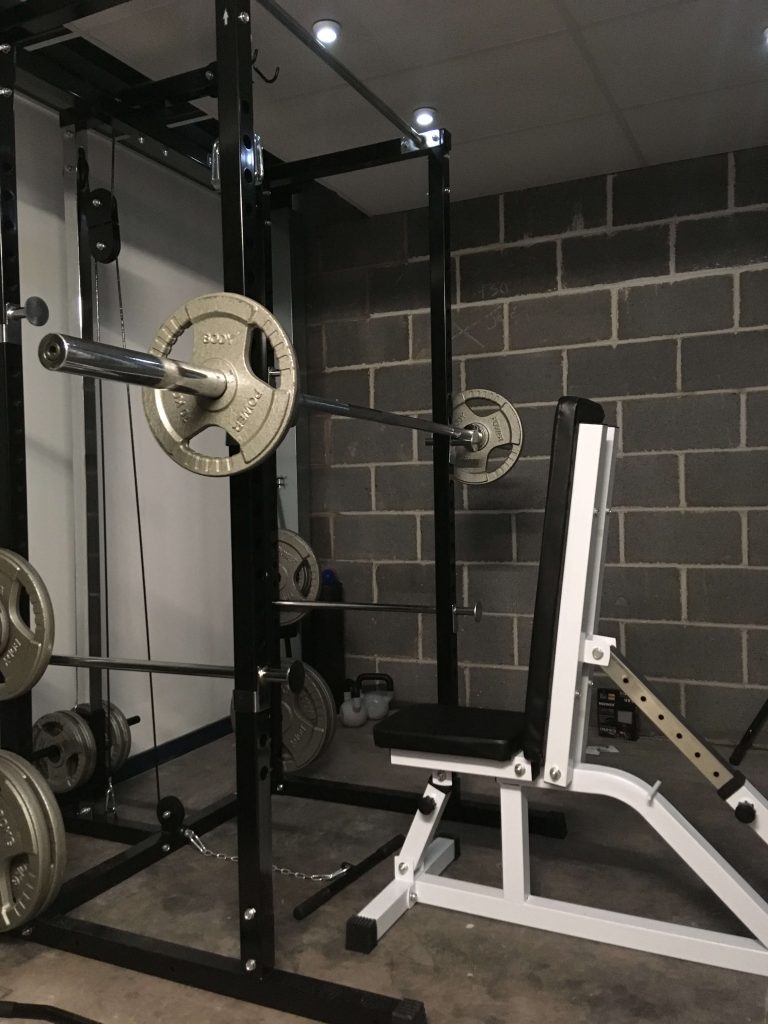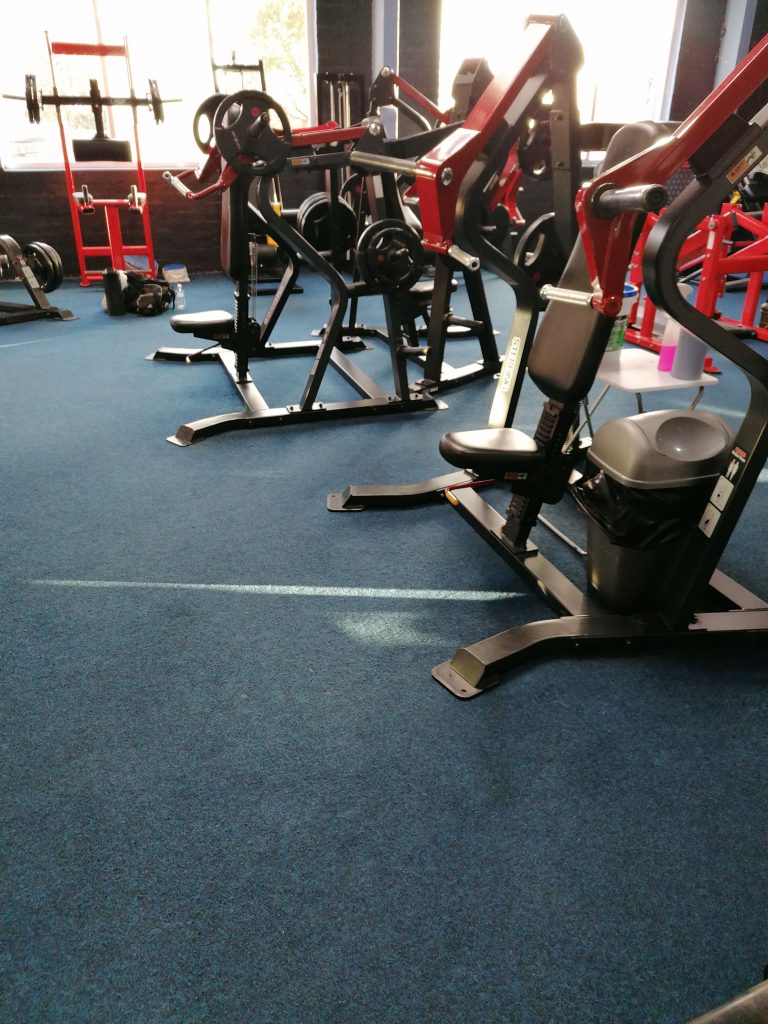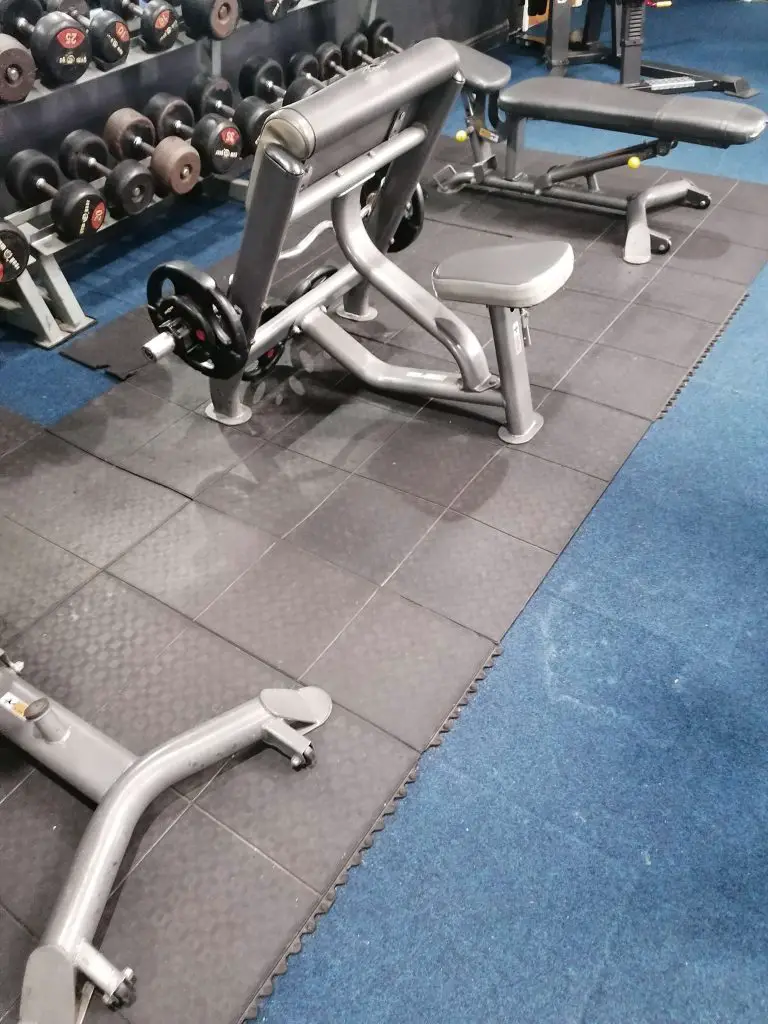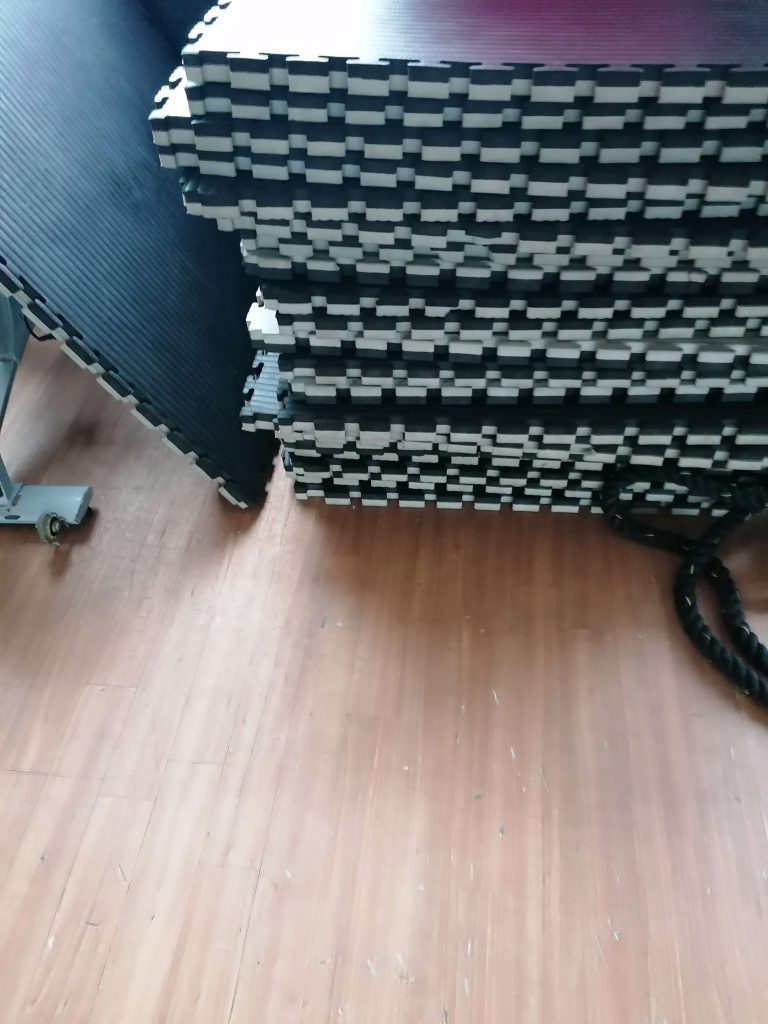The fun part of setting up a garage gym is buying all of the equipment. The not-so-fun part of setting up a garage gym is making it fit for purpose from a structural and usable perspective!
One of the most important things to get in place when setting up a garage gym is the flooring. Garage gym flooring needs to serve multiple purposes that are specific to training and weightlifting. It’s not a factor to overlook if you want to not only train efficiently but also keep your equipment and garage itself in good condition.
Therefore, we’ve compiled a complete guide below running through everything you need to know when considering garage gym flooring. This includes:
- What to use for garage gym flooring
- How to install garage gym flooring
- The different types of garage gym flooring
- What NOT to use for garage gym flooring
- Some additional FAQs
Why Do You Need Flooring for a Garage Gym
Join any Facebook home/garage gym group and one of the most frequent questions you’ll find is:
“What should I use for garage gym flooring”
It’s easy to assume (before looking into it) that whatever material or surface you have for a garage floor will surely be good enough to support training and workout equipment. If a garage floor is designed well enough to drive a car over, surely it’s good enough to lift weights on?
Well, yes and no. Roughly 99% of garage gym floors will be structurally sound enough to support weights and fitness equipment (cardio machines, power racks, cable machines, weight plates, dumbbells, etc..). Garages are set at ground level and unless you have a structural issue that you might not be aware of, the weight will not be an issue.
For a home gym, the weight limit will be an issue when setting up gym equipment upstairs or on a second floor but this will rarely be an issue for a garage gym.
The main reason why you need specific garage gym flooring is for all the other factors that do not involve a weight limit.
There are 5 key reasons why you need specific flooring for a garage gym:
- To absorb shock from dropped weights. This protects your garage foundations as well as the weights and equipment
- To provide stability for gym equipment minimizing slips or sliding machines
- Act as a form of insulation to keep your garage gym heated
- Helps minimize dust and moisture whilst also being more hygienic (it’s easier to clean)
- More comfortable to train on due to shock absorption. It’s much easier on your joints than a solid concrete floor
It’s easy to dismiss some of these points, especially the more ‘boring’ points like dedicated flooring being easier to clean but if you want to create a great gym and somewhere you want to train then it starts from the foundations up.
Different Types of Garage Gym Flooring
Garage gyms are still a growing trend – more so now than ever before – as people want to rely less on having a gym membership when they can work out from the comfort of their own homes.
This does mean that there isn’t a standardized flooring solution for a garage gym. There is definitely a standard for a commercial gym, however, with a home or garage gym, people really want to get creative.
Below are just some of the types of flooring people use for a garage gym.
Note – these are not our recommendations, we’ll have some ideal options that we cover shortly.
Concrete

A concrete floor is the default option for a garage gym. The reason for this is that most garages will be made from a concrete floor so, from this perspective, you won’t need to do anything in order to start training. We’ll get onto some of the pros and cons of this later but as a first option, you could use the concrete base already in place in your garage as the flooring option.
This is the complete budget option (doesn’t cost anything), but it should be a starter option only, and even then, we still wouldn’t recommend it!
Rubber Gym Flooring
The most popular (and recommended) option for garage gym flooring is rubber mats. These come in a variety of styles which include interlocking gym mats, rolling rubber mats, heavy-duty rubber tiles, and even some cheaper rubber options.
The reason rubber is such a popular choice for gym flooring is primarily for shock and impact absorption. What do we mean by this? Well, dropping weights, running on a treadmill, and doing bodyweight exercises all involve impact with the floor.
This impact can be equipment or your joints and both of these things are something you’d want to protect!
Not only that, but the shock absorption also means that the flooring itself has added longevity.
Horse Stall Mats
Following on from the above, horse stall mats have become a budget alternative to specific rubber gym flooring.
Home gym builders are an innovative bunch, we don’t build these gyms as a profession so hunting for bargains and DIY solutions are all part of the fun. Arguably the most popular option for garage gym flooring is horse stall mats.
These mats are made from heavy-duty rubber meaning they carry most of the same benefits as dedicated rubber flooring and are also cost-effective.
The issue with horse stall mats is threefold: they are not custom made so need to be cut to size, they are incredibly heavy and difficult to install, and they also don’t smell great and hold moisture which can lead to mold and mildew.
Carpet

Laying carpet is a quick solution for many garage gyms. With a layer of foam insulation underneath, you’ll have a certain degree of shock absorption protecting your weight plates, equipment, and foundations.
Carpet is also good for ventilation to add heat to a garage during the winter and will also help to keep your garage gym cool in the summer. The main issue with carpet in a garage gym is how easily it will stain, it will absorb moisture like sweat making it smell bad and unhygienic, and it won’t fully protect the concrete foundation or your weights from impact.
Vinyl
Vinyl in the form of tiling or laminate is the most popular option for those looking for an aesthetic gym that’s Insta-ready. Vinyl looks good in terms of design but from a function perspective, this is one of the worst options.
Vinyl damages and warps easily, especially in most atmospheres like… a gym. This is an OK option if your gym consists of cardio or fixed weight machines like a multi gym but if your garage gym will have any sort of free weight training or HIIT, it will be a bad option.
AstroTurf
Astroturf is a trendy option for garage gym flooring, especially in small sections for sled drags or pushes and it works well for HIIT training.
For a full flooring option, it can be incredibly expensive. Most Astroturf has a heavy-duty rubber base so it has many of the same benefits as regular rubber flooring but it’s also significantly more expensive and requires more maintenance which is why most people only use it for a small section of their gyms.
Wood Flooring
Many people, especially those based in the UK or Europe, don’t quite have the same luxury of space in their garage that those in the states or Canada are used to and for that reason, wood paneling like sheets of OSB or chipboard are often used to support a garage gym.
Think of a deadlift platform and then imagine that covering the entire garage floor. While wood is definitely a cheap and convenient option, especially for distributing load (ideal for dropping weights), it’s not a great option to be a dedicated flooring solution.
While it’s cheap and easy to install – if you have the DIY ability – it will also absorb moisture, sweat, and water which will eventually lead to rotting and the growth of mold. No matter how much you treat it, keeping a wooden floor in good condition will be more difficult than getting something more fit for purpose.
What Is the Best Flooring for a Garage Gym
While all of the types of garage gym flooring are “usable” there are definitely some that are better than others. Below are what we – and industry experts – consider to be the best flooring options for a garage gym.
#1 Rubber Flooring Tiles

Rubber floor tiles are the best option for garage gym flooring. These tiles are specially made and provide a number of benefits which include:
- Reduce noise
- Shock absorption to minimize damage to equipment or the floor
- Easy to install – even for beginners
- Comfortable to train on
- East to clean and maintain
The benefits of rubber flooring are going to be similar regardless of the type of floor you choose, however, the key benefit of rubber flooring tiles for garage gym owners is that they are easy to install. This is a key factor to take into consideration as you’ll want to minimize gaps between the rubber to prevent the buildup of moisture, dampness, and mold whilst also being able to install it easily yourself.
The only downside to rubber gym tiles is that they are custom made (a specialized piece of equipment) and therefore come at a higher price than most other types of flooring.
#2 Heavy-Duty Rubber Gym Mats
As dedicated gym tiles are a more specialized option, a cheaper option is to purchase some heavy-duty rubber gym mats. These offer all the same benefits as gym tiles but they come in a variety of sizes and don’t necessarily have interlocking functionality.
This means you’ll need to cut them to size in order to fit your space which is not an easy task with heavy-duty rubber. For most garage gym owners though, this mid-price option is arguably the most popular and widely used.
#3 Horse Stall Mats
Horse stall mats are the ultimate budget option for a garage gym builder. These horse stall mats are heavy-duty rubber and therefore ideal for shock absorption from dropped weights and heavy lifting. The other key benefit is of course that you can pick these up relatively cheap.
This is a more popular option for UK-based garage gym owners as they are more readily available – the key with this option though is to buy used. This reduces the price significantly, however, you’ll need to clean them extensively before installing them which is a very manual process.
The issue with horse stall mats is not only cleaning them but actually laying them for flooring. Trying to cut them to size in order to fit a garage is a very difficult task and for the effort you’ll be putting in during installation, this should only be an option for the most budget-strapped garage gym builder.
What Gym Flooring Is the Worst for a Garage Gym (What to Avoid)
While there are some types of flooring that are best for a garage gym, there are also some that can be considered the worst!
#1 Wood
While being a popular option, a wood floor will end up being more trouble than it’s worth in terms of the issues you’ll face with this type of flooring. Unless you are going to install a heavy-duty hardwood floor (we mean using very thick wood), you’ll struggle to make wood workable.
There are three common reasons for wood being a bad choice for garage gym flooring:
- You’ll need to spend time and money treating the wood to prevent mold, rot, and warping
- Most wood won’t be able to absorb the impact of dropped weights, even when it’s distributing the load throughout an area
- There’s no shock absorption so it’s definitely not a comfortable option
#2 Concrete
Leaving your garage floor without any gym flooring is arguably the worst type of flooring you can use. The concrete base for a garage gym – meaning no additional flooring and just the bare concrete – is a recipe for damaged equipment and damaged property.
Concrete is the best foundation for a garage gym floor, however, it’s not the best option for flooring. Without a buffer to absorb impact, the concrete floor will take repeated damage over time from dropped weights and will also damage your weight plates and barbell.
Damage to the floor can also lead to damage to the foundation and structure of your garage and also your home!
If you build a dedicated deadlift platform or weightlifting platform then this will help but you shouldn’t train on just the concrete floor.
#3 Foam Gym Mats

As a cheap alternative to rubber, interlocking foam gym mats are a popular consideration for garage gym flooring but this is often a mistaken thought. Foam gym mats are used in areas of low impact such as yoga, stretching, or martial arts – They are not to be used for heavy weightlifting.
While they are a good addition to an existing floor (an exception where you could use wood or tile), they are good to use for cardio machines, fixed weight machines, and bodyweight work but should not be used for any type of heavy weightlifting.
#4 Tile or Vinyl
In terms of structure, tile or vinyl options are by far the weakest and most vulnerable for a garage gym floor. The materials for these options look good and are definitely the aesthetic option, but from a practical perspective, they won’t be able to take any sort of impact from weights – even just placing them down as opposed to dropping them.
Essential Gym Flooring Tips
Before buying or installing garage gym flooring, there are a number of things you need to do to prepare the area whilst ensuring that all materials are fit for purpose and use.
Firstly, it’s always a good idea to seal a concrete floor before attempting to lay or install any kind of additional flooring. You can use a basic concrete sealing paint for this and it has a number of benefits which include preventing a buildup of dust and making it easier to lay flooring over.
Next, you’ll want to measure your area twice. Gym flooring is not cheap and they’ll be nothing worse than finding you’ve not ordered enough material to cover your entire space. You also don’t want to over-order on material which is just wasteful!
If you want a helpful resource, check out this video guide below on how to properly install garage gym flooring:
Garage Gym Flooring FAQ
Below we’ll quickly cover some of the general questions that people have when it comes to choosing or installing garage gym flooring. These are going to be some brief and precise answers so that you can move on and make a start getting your garage gym floor in place!
How Thick Should Garage Gym Flooring be?
Garage gym flooring should be a minimum of 8mm thick with a recommended thickness of 12” needed to absorb the impact from heavy weightlifting and dropping in excess of 200lbs.
Is Gym Flooring Necessary?
Garage gym flooring is not only necessary but an essential component that is needed to protect both your home’s foundations as well as your gym equipment from damage. By not placing down dedicated flooring, you risk damaging both the concrete or wood/beam foundation to your garage as well as damaging your equipment.
How Do You Secure a Garage Gym Floor?
Properly installing your garage gym floor is crucial. If you opt for rubber matting and it slips during use, you risk injury to yourself and this is true with other types of flooring as well. Therefore, the first step would be to get professional installation.
A number of companies specialize in garage floor installation and some even specialize in garage gym floor installation. A carpenter or general handyman are all additional options to consider. If however, you want to take a DIY approach then you need to consider the following:
- Ensure any screws used to secure rubber matting are designed for the foundation underneath (wood screws, concrete screws, etc..)
- Use a leveling compound combined with screening to ensure your garage gym floor is level before adding any flooring
- Use a layer of foam insulation underneath the flooring material you are going to use to prevent the buildup of moisture by allowing air to flow.
Final Thoughts
Garage gym flooring is one of the most important items that you need to install before you buy any equipment or start to train. The proper flooring has a range of benefits which include the protection of your floor and equipment, a more comfortable training surface, noise reduction, and ease of cleaning/maintenance.
For all the benefits that you can get with gym flooring, you need to ensure you are choosing the correct option to suit your needs. The best garage gym flooring is rubber, specifically heavy-duty rubber gym mats or rubber gym tiles.
These provide all the benefits needed to have the ultimate gym set up in your own home. While it can be tempting to provide a certain aesthetic for your garage gym, if you do any kind of heavy weightlifting, you’ll need to avoid wood, vinyl, concrete, and foam flooring as these options are just not fit for purpose.

